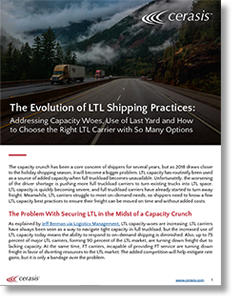Applying Vital Less-than-Truckload Capacity Best Practices When Freight Volume is Tight

LTL carriers have always been seen as a way to navigate tight capacity in full truckload, but the increased use of LTL capacity today means the ability to respond to on-demand shipping is diminished.
Less-than-Truckload (LTL) and Tight Freight Capacity
The capacity crunch has been a core concern of shippers for several years, but with the 2018 holiday shopping season in full swing, it has become a bigger problem.
LTL capacity has routinely been used as a source of added capacity when full truckload becomes unavailable.
Unfortunately, the worsening of the driver shortage is pushing more full truckload carriers to turn existing trucks into LTL space.
LTL capacity is quickly becoming harder to find, and full truckload carriers have already started to turn away freight.
Meanwhile, LTL carriers struggle to meet on-demand needs, so shippers need to know a few LTL capacity best practices to ensure their freight can be moved on time and without added costs
The Problem With Securing LTL in the Midst of a Capacity Crunch
As explained by Jeff Berman via Logistics Management/Supply Chain 24/7, LTL capacity woes are increasing.
LTL carriers have always been seen as a way to navigate tight capacity in full truckload, but the increased use of LTL capacity today means the ability to respond to on-demand shipping is diminished.
Also, up to 75 percent of major LTL carriers, forming 90 percent of the LTL market, are turning down freight due to lacking capacity.
At the same time, FT carriers, incapable of providing FT service are turning down freight in favor of diverting resources to the LTL market.
The added competition will help mitigate rate gains, but it is only a bandage over the problem.
LTL Capacity is Both Resilient and Fragile at the Same Time
Part of the reason for increased use of LTL freight rests on driver wages and treatment.
In LTL, drivers can make significantly more in annual salaries than FT drivers, and as noted by John D. Schultz of Logistics Management & Supply Chain 24/7, benefits for LTL drivers may also be higher.
Some of the top 25 LTL carriers are now offering $10,000 bonuses to drivers who stay with the company for at least one year, and the same tactics are being in used FT.
Unfortunately, there are not enough drivers to go around, so knowing how to navigate the shortage through LTL is essential to controlling freight spend.
LTL Capacity Best Practices to Keep Freight Spend Under Control
According to Todd Johnson of Supply Chain Brain, shippers need to start thinking about how to ensure drivers and carriers want to continue the relationship.
It is a real relationship, requiring fairness, kindness, and respect, and being a preferred shipper, also known as a shipper of choice designation, is a great start.
Some of the critical characteristics of a preferred shipper include:
- Offer open availability to other necessities, like restrooms and even showering facilities. Making drivers feel welcome to your facility, including the creation of breakrooms to give drivers an opportunity to rest can both improve driver mental state and reduce the impact of detention on HOS records.
- Limit the amount of time spent waiting for loading and unloading. Any conversation about the importance of keeping drivers happy must touch on the need to be on time with loading and unloading. Unnecessary delays in the yard will adversely affect HOS adherence and impact drivers’ ability to perform their duties.
- Communicate delays. When delays do occur, drivers should be kept informed. This may also help drivers picking up multiple shipments in a local area by rerouting trucks to avoid unnecessary waiting.
- Be understanding of driver mistakes or tardiness. There will be times when drivers are late or make mistakes. Shippers should be reasonable and understanding when uncontrollable issues arise.
- Provide convenient, well-lit parking areas. This tip is similar to creating driver-rest regions, but it is also focused on making drivers’ entries and exits from a yard easy.
The Shipping Surge Will Continue
E-commerce growth for 2017 was just shy of 3 percent, but that number has already been exceeded in 2018.
With the holiday shipping season expected to bring even stronger gains for retailers, demand on carriers for more capacity and faster shipping will reach its tipping point.
Shippers that have not yet created a plan and implemented LTL capacity best practices will be hit hardest with record-breaking spot rate hikes and even refusals from carriers.
However, the surge in e-commerce could benefit small and mid-sized LTL carriers and bring renewed competition to the sector.
Related: 9 Indispensable Tips on How to Choose the Right Regional Less-than-Truckload Carrier
Related LTL White Papers
The Evolution of LTL Shipping Best Practices New!
This exclusive, & educational white paper is for shippers who are accustomed to shipping LTL freight or are starting to ship more LTL freight, it addresses capacity woes, use of last-mile delivery, and how to choose the right LTL carrier. Download Now!
Current Factors Driving the Less Than Truckload Pricing Market New!
This white paper is a must-read for shippers who are seeking information on the less than truckload pricing market in order to plan for 2019. Download Now!
The State of & Pricing Outlook of the Less than Truckload Shipping Market
This is a must-read for shippers who are either LTL shipping pros, new LTL shippers who are needing education, or those moving more freight to the LTL mode as Full Truckload feels the capacity crunch squeeze. Download Now!
8 Big Factors to Consider for Efficient Less-than-Truckload Shipping
In this all-new e-book, we discuss the 8 core areas that Less-than-Truckload shippers can focus on in order to have more efficient LTL shipping practices. Download Now!
More Resources from Cerasis
Article Topics
Cerasis News & Resources
GlobalTranz Appoints Executive Chairman Bob Farrell as Chief Executive Officer Amazon’s Drone Delivery Hits Milestone with Federal Aviation Administration Clearance Digital Supply Chain: The Landscape, Trends, Types, and the Application in Supply Chain Management Walmart’s Bid for TikTok Could Benefit the Retail Giant’s Ecommerce and Advertising Businesses The State of Ecommerce Logistics Heading into 2020 Peak Delivery Season Bringing Omnichannel to the Forefront of Ecommerce FedEx’s Fred Smith Optimistic About Economic Recovery as Ecommerce Business Booms More CerasisLatest in Transportation
Baltimore Bridge Collapse: Impact on Freight Navigating Amazon Logistics’ Growth Shakes Up Shipping Industry in 2023 Nissan Channels Tesla With Its Latest Manufacturing Process Why are Diesel Prices Climbing Back Over $4 a Gallon? Luxury Car Brands in Limbo After Chinese Company Violates Labor Laws The Three Biggest Challenges Facing Shippers and Carriers in 2024 Supply Chain Stability Index: “Tremendous Improvement” in 2023 More Transportation



















